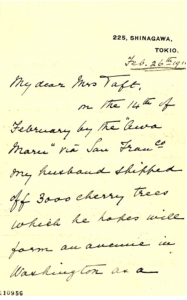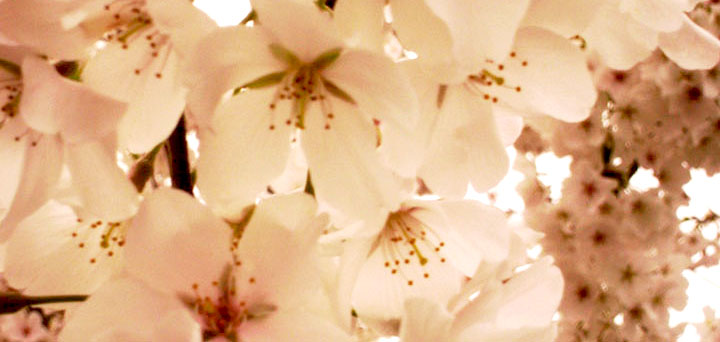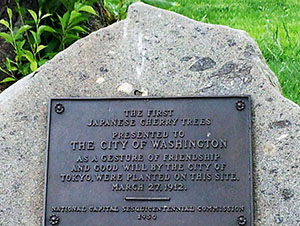(I hope) the trees “will form an avenue in Washington as a memorial of national friendship between the U.S. and Japan.
~ from the Mayor of Tokyo, Japan, written by his wife, Yei Theodora Ozaki in a 1912 letter to First Lady Helen Taft
 A Gift of Friendship
A Gift of Friendship
In 1895 Mrs. Eliza Ruhamah Scidmore began a 25 year campaign to have cherry trees planted along the Potomac waterfront. From 1906-1908 Dr. David Fairchild tested cherry trees for the hardiness in the DC area and with his wife promoted the planting of cherry trees for Arbor Day. In 1909 Mrs. Scidmore sought to raise money for the planting of cherry trees throughout the District and wrote First Lady Helen Taft who responded favorably. In 1910, 2,000 cherry trees arrived in Washington, DC but an inspection found that they were diseases and infested with insects and nematodes. The Department of Agriculture concluded that the trees must be destroyed. Deeply concerned, Tokyo Mayor Yukio Ozaki and others suggested a second donation be made and on March 26, 1912 3,020 cherry trees arrived in Washington, D.C.
On March 27, Helen Herron Taft and the Viscountess Chinda, wife of the Japanese Ambassador, planted two Yoshino cherry trees on the northern bank of the Tidal Basin, about 125 feet south of what is now Independence Avenue, SW. At the conclusion of the ceremony, the first lady presented a bouquet of “American Beauty” roses to Viscountess Chinda. Washington’s renowned National Cherry Blossom Festival grew from this simple ceremony, witnessed by just a few persons. These two original trees still stand several hundred yards west of the John Paul Jones Memorial, located at the terminus of 17th Street, SW. Situated near the bases of the trees is a large bronze plaque which commemorates the occasion.
National Cherry Blossom Festival
Washington, DC’s National Cherry Blossom Festival is an annual two-week, city-wide event featuring more than 200 international cultural performances and over 90 other special events. From arts and exhibits to cuisine and sports, there is something for everyone to enjoy!
While the blossoms are dependent on weather conditions and light, the Festival is held late March to mid-April when approximately 70 percent of the now 3,700 trees are in bloom. Exactly when the buds will open is not easy to predict and it is extremely difficult to give an accurate forecast much more than 10 days before peak bloom. National Park Service horticulturists monitor five distinct stages of bud development and provide timely forecasts and updates.
The Peak Bloom Date is defined as the day on which 70 percent of the blossoms of the Yoshino cherry trees that surround the Tidal Basin are open. This date varies from year to year, depending on weather conditions. The Blooming Periodis defined as that period when 20 percent of the blossoms are open until the petals fall and leaves appear. The blooming period starts several days before the peak bloom date and can last as long as 14 days, however, frost or high temperatures combined with wind or rain can shorten this period.
The National Park Service offers a bloom schedule, a cherry tree map, a calendar of events, information on the Cherry Tree Replacement Endowment Fund and a live National Mall and Memorial Parks Cherry Blossom Web Cam that looks NorthWest across the Tidal Basin from the Thomas Jefferson Memorial.
Japanese Cherry Tree Commemorative Marker
Off Independence Avenue, east of West Basin Drive, SW
GPS Coordinates: 38.887033, -77.044959
There is limited parking along Ohio Avenue.
Click on WMTA Walking Directions to access the path via the MLK Jr. National Memorial
The Marker is accessible 7 days a week, 24 hours a day, but it is best to visit between sunrise and sunset.
The Marker is on the north bank of The Tidal Basin in West Potomac Park, just off Independence Avenue, east of West Basin Drive. It is best to park (perhaps near the MLK Jr. National Memorial) and walk along the cherry tree-lined path to access the Marker.
This Plaque commemorates the 1912 gift of 3,020 cherry trees from the city of Tokyo to the people of Washington, D.C. which became the origin of DC’s annual National Cherry Blossom Festival. These trees are a living reminder of the good will and friendship shared by the peoples of Japan and the United States.
In March 2012, one century later, the US reciprocated by presenting Japan with 3,000 dogwood trees to be planted in a Tokyo park. (Christian Science Monitor, 04/30/2012)





